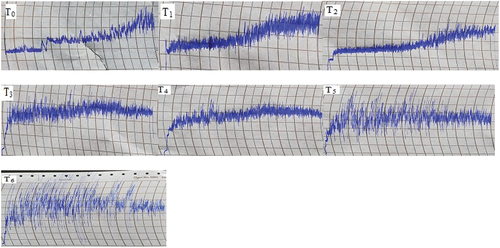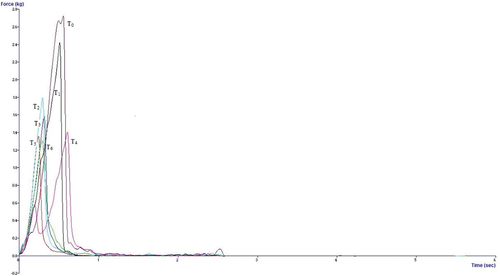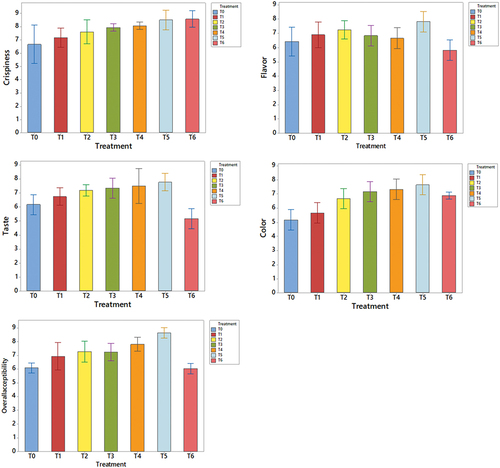Abstract
The incorporation of oat grain fiber (ultrasound-assisted extraction) into the dough was evaluated for its rheological characteristics. Spread ratio increased significantly with an increase in the level of oat fiber. The color tonality of biscuits significantly decreased its L*, b*, C, and hab factors, while the a* factor increased with the level of fortification. A textural study of biscuits showed that less shear force is required to break the biscuits with maximum oat fiber incorporation. Mixograph, Farinograph, and RVA analysis showed that maximum fiber incorporation significantly affected dough stability and development time. With increasing fortification biscuits showed a decrease in protein contents and total carbohydrate contents while fiber and ash contents increased significantly. Non-significant differences among all treatments for fat contents were observed. Dough with 20% incorporation of oat fiber showed good rheological and sensory attributes as compared to 24% fortification (the maximum fortification level). Novel products with improved rheology can be introduced in the market as functional foods against various diseases and product stability.
PUBLIC INTEREST STATEMENT
Oat fiber is a readily available and inexpensive source of dietary fiber. The addition of oat grain at their optimum levels led to dietary fiber-enriched biscuits with improved functional and nutritional properties and without undesirable changes in their sensory properties. The addition of fiber has improved various properties of wheat dough such as water absorption capacity, dough development time, mixing time, softness of dough, dough stability, mixing tolerance index, and peak height. Utilization of fiber in cereal-based products can fulfill many objectives including improving product quality, shelf life, value addition, and maintaining the good health of the consumers. Novel products with improved rheology can be introduced in the market as functional foods against various diseases such as diabetes mellitus, cancer, and bacterial infections.
1. Introduction
Oat (Avena sativa. L) is the fifth largest grown cereal crop in the world. Its grains are equally important both for the livestock and poultry feed sector. Its grains are enriched with a lot of potential phytochemicals having functional properties in maintaining the well-being of humans (Abou-Raya et al., Citation2014). Oat is a functional and nutritional cereal crop and a good source of β-glucan, arabinoxylans, phenolic, vitamins, protein, mineral and unsaturated fatty acids, and cellulose.
Dietary fiber incorporation in cereal and other food products to increase their functional properties has attained importance in the present scenario because of increasing consumers’ concern towards healthy lifestyles. Oat fiber is the combination of both soluble and insoluble fiber having glucosyl units linked by β-(1→4) and β-(1→3) linkages. Functional ingredients not only impart health benefits but also affect the sensory parameters and processing ability of the end product. Dietary fiber improves the textural properties and rheological properties of the food and has a physiological function in the host including bowl regulation, cholesterolemia, glycemia, and insulinemia. Dietary fiber has health benefits including gastrointestinal function, lowering postprandial glycemic index, and lowering the risk of cardiovascular disease, metastatic disease, and colon cancer (Tufail et al., Citation2020).
Biscuits are a low-cost, easily available, and equally popular food item in both rural and urban communities. Rheological parameters determine the ultimate processing efficacy and consumer acceptability of the baked products. Higher fiber contents incorporation in dough used for biscuits increases water absorption, and stress—strains resistant structure resulting in longer perishability. Rheological parameters studied by the rapid visco analyzer, mixograph, and farinograph showed that there is a gradual decrease in peak viscosity, setback, final viscosity, and through viscosity. There is a gradual increase in the water absorption ability of the dough with increasing fiber contents due to competition among gluten content and fiber contents of the mix (Cappelli et al., Citation2018; Liu et al., Citation2019; Tufail et al., Citation2020). Oat fiber increases water absorption ability and decreases the oil absorption capacity of dough. The mechanical energy produced by the mixer is reduced by increasing fiber contents in the dough and decreasing elongation viscosity and hardening index (Arufe et al., Citation2017).
Bakery products are enriched with dietary fiber from cereal sources to improve the nutritional profile of the end product, and to attract the final consumer. Fiber particle size distribution defines its solubility and modifies starch pasting properties (Canalis et al., Citation2019). Rheological studies revealed that incorporation of oat fiber increases dough energy but decreases its extensibility. Starch gelatinization and protein structure are affected by the oat fiber in the dough. High fiber incorporation in bakery products affects the viscoelastic properties of the dough matrix, hence producing a deleterious effect on the sensory attributes of the final baked products. Physicochemical modification of the fiber by using extrusion improves its functional properties. Fiber visco elastic system of dough results in a weak dough and it competes with starch contents for water contents, thus ultimately affecting the pasting and gelling properties.
This study was designed to explore the effect of ultrasound-assisted extracted fiber on rheological parameters of fiber-incorporated dough, color tonality, texture analysis, and sensory attributes of fiber-incorporated biscuits. The fortification was done at levels (0%, 4%, 8%, 12%, 16%, 20%, and 24%). Farinograph, mixograph, and viscosity analysis of dough were done. Biscuits were prepared with an above-cited level of fortification and analyzed for different physicochemical and sensory attributes.
2. Materials and methods
2.1. Procurement of raw material and preparation of oat fiber incorporated flours
Oat and Wheat were purchased from Ayub Agricultural Research Institute, Faisalabad. All the ingredients used in the preparation of biscuits were purchased from the local market. After milling wheat flour was obtained and after grinding, oat fiber was extracted by ultrasound assistance assisted extraction by using the Box Behnken design (Surin et al., Citation2020). The extraction was optimized by three factors at three levels (time, temperature, and amplitude). Oat fiber was extracted. Then, wheat flour proportion was substituted in the combination of 0%, 4%, 8%, 12%, 16%, 20%, and 24% for the preparation of biscuits with oat fiber.
2.2. Preparation of biscuits from oat fiber-incorporated flour
Oat fiber incorporated flours were mixed separately in a dough mixer to prepare the dough. Dough was then kneaded well to have a uniform consistency. Biscuits were prepared according to the recipe as described by Krystyjan et al. (Citation2018) with some modifications in the ingredients. Wheat flour 100 g, sugar powder 17 g, butter 20 g, whole egg 50 g, salt 5 g, baking powder 3 g, and 2–3 drops of vanilla flavor were used to make the 100-g dough. Kenwood mixer was used for mixing sugar and butter until the fluffy mixture was obtained. Eggs, baking powder, salt, and refined wheat flour with different combinations of oat-extracted fiber were mixed to form the soft dough. The vanilla flavor was also added during mixing to give a better flavor to the baked biscuits. Dough was rolled into sheets and cut with the cutter. The cut mass was transferred to the baking tray and baked at 172°C for 15 min. Control was made with 100% wheat flour. After baking, the biscuits were placed in plastic trays and wrapped with aluminum foil for further analysis.
2.3. Rheological properties of oat fiber incorporated flour
2.3.1. Pasting properties
The pasting properties of the flour incorporated by six different proportions of oat fiber were measured using a Rapid Visco analyzer (Newport Scientific, Australia) as described in method No. 76–21 (AACC, Citation2000). 3.5 g wheat flour incorporated with oat fiber was added in a rapid visco-analyzer cylinder and 25 ml of distilled water was added and the process was run for 13 min. The test was repeated three times, and the mean value was taken from three replicates.
2.3.2. Farinograph studies
Farinograph (Brabender DUISBURG 380, Germany) was used to study the rheological properties of the fiber-incorporated flours according to Method No. 54–21 (AACC, Citation2000). Sigma-Kneter 300 g was used. First, moisture was determined and then put the required amount of fiber incorporated flours in it. After 1 min of dry mixing water was added until Farinograph reached the 500 BU line. The process was run for 20 min. The test of each treatment was repeated three times, and the mean value was taken from three replicates.
2.3.3. Mixograph studies
Mixograph (Model: National Mfg. Co., Lincoln, Nebraska) was used to study the mixing behavior of the wheat flour incorporated with different concentrations of the Oat fiber. The Mixograph study was carried out according to method No.54-40A (AACC, Citation2000). Ten-gram fiber incorporated wheat flour was put in the mixing bowl of the mixograph. Dry mixing was carried out for 1 min and then 6 ml water was added and mixing was continued for 10 min. The test of each treatment was repeated three times, and the mean value was taken from three replicates.
2.4. Physical parameters of oat fiber incorporated biscuits
2.4.1. Spread ratio of biscuits
The spread ratio of biscuits was measured according to Ajila et al. (Citation2008) procedure, dividing the diameter of six biscuits by their thickness. The test was repeated three times, and the mean value was taken from three replicates.
2.4.2. Color tonality of biscuits
The surface color of biscuits was analyzed by using Konica MINOLTA Chroma meter-410 (sensing Inc., Tokyo, Japan), regarding illuminant D65 and a visual angle of 10°, using the CIE Lab system. The test was repeated three times for each treatment, and the mean value was taken from three replicates.
2.4.3. Texture analysis of the biscuits
The hardness value of cookies was determined through Texture Analyzer (TA-XT2, Plus, Stable Microsystems, Surrey, UK). TA-XT Plus texture analyzer having a 3-point bend rig (HDP/3 PB) using a 5 kg load cell and heavy-duty stainless steel platform (Stable Micro Systems, Great Britain) was used to measure the hardness and fracture ability of the fiber-incorporated biscuits. The experimental conditions were followed as suggested by Panghal et al. (Citation2019). The test was repeated three times for each treatment, and the mean value was taken from three replicates.
2.5. Chemical analysis of biscuits
Cookies prepared by incorporation of different concentrations of dietary fiber were evaluated for chemical compositions including fat, protein, ash, total dietary fiber, insoluble dietary fiber, soluble dietary fiber, and total carbohydrate contents according to the methods described in Horwitz and Latimer (Citation2006). Total carbohydrate contents were determined on a different basis. The results were given as the average of three replicates for each treatment.
2.6. Sensory analysis of biscuits
The sensory evaluation of fiber-incorporated cookies was done by 30 trained and semi-trained panelists, including postgraduate students and academic staff members of the Institute of Food and Nutritional Sciences PMAS-Arid Agriculture University Rawalpindi. Nine points hedonic scale was used for sensory parameter quantification (1 is for extremely dislike and 9 is for extremely like).
2.7. Statistical analysis
Data were analyzed by one-way analysis of variance (ANOVA) using Statistica v. 8.0 software (StatSoft, Inc., Tulsa, OK, USA). The least significant difference, at the confidence level of 0.05 was calculated.
3. Results and discussion
3.1. Pasting properties of oat fiber incorporated flour
The results of fiber incorporation in the dough are narrated in (Table ). Pasting profile of the dough, swelling, and gelatinization of starch with different levels of fiber incorporation was studied through RVA. The system recorded mix behavior in heating and cooling and recorded the final viscosity of the mix after heating. The mix after heating is considered composite material with continuous phase and swollen starch particles. The control showed the highest breakdown, least pasting temperature, least peak time, Peak1, highest setback, though, and the highest final viscosity, respectively. Break down, Peak1, through, and final viscosity decreased by increased incorporation of fiber. Meanwhile, pasting temperature and peak time have increased with an increased level of incorporation.
Table 1. Pasting properties and farinograph study of fiber-incorporated dough
Starch pasting properties are affected by the fiber incorporation at a different level, ultimately decreasing the final viscosity with increased levels due to fewer starch granules available to gelatinize (Rocha-Parra et al., Citation2015). Although the dietary fiber is the resistant starch and cannot be digested by the monogastric (due to lack of cellulose enzyme) due to its non-digestive ability it did not exhibit the same gelling and swelling ability as starches (digested by monogastric).
3.2. Farinograph studies of oat fiber incorporated dough
Farinograph analysis of the fiber-incorporated dough is presented in (Table ). Results showed that with increasing fiber level, water absorption, and weakening degree, dough formation time decreased, while dough stability time decreased. Fiber incorporation decreased the gluten contents. Fiber and protein have hydroxyl groups and compete for water absorption, ultimately affecting dough stability and development (Biernacka et al., Citation2017; Różyło et al., Citation2017). Dietary fiber competes with other ingredients of wheat flour specifically with protein and starch for water absorption (Mehfooz et al., Citation2019). The study confirmed the findings of (Liu et al., Citation2019; Nawrocka et al., Citation2016) that higher fiber contents increase water absorption, and dough formation time and adversely affect the gluten network structure.
3.3. Mixograph studies of oat fiber incorporated dough
Results of fiber incorporation are narrated in (Figure ). Mixograph indicated that fiber concentrations adversely affected dough development by affecting protein and starch, leading to poor viscoelastic strength. Six levels of oat fiber incorporation were studied. Water holding and absorption capacity of flours increased and the general shape and tolerance of the mixograph changed with the increase in the level of fiber fortification as compared to the control. The mixograph showed dough development time, starch gelatinization, protein breakdown, enzymatic activity, and gel strength and indicated that with a higher concentration of fiber, there was a significant decrease in dough stability.
3.4. Physical Parameters of Biscuits
3.4.1. Spread ratio of fiber-incorporated biscuits
The results of the physical parameters of the fiber-incorporated biscuits are shown in (Table ). The results indicated that there was a significant difference in the spreadability of the baked biscuits. Dough consistency and strength depend upon the gluten contents. The addition of fiber impacted the dough’s strength by altering the gluten content. Fiber competes with the gluten contents for the absorption of water. Dough texture and consistency were weakened by the incorporation of fiber contents and the spreadability of biscuits increased with increased fiber contents (Lee & Inglett, Citation2006). Spreadability of the biscuits is strongly correlated with the gluten contents of the dough (Krystyjan et al., Citation2018; Zouari et al., Citation2016). The highest spread factor was observed in T6 having maximum fiber incorporation and control showed the least spreadability. The present study confirmed the previous findings of (Adeola & Ohizua, Citation2018).
Table 2. Spread factor and color tonality of the oat fiber-incorporated biscuits
3.4.2. Color of fiber-incorporated biscuits
External appearance determines whether food is fit for final consumption. The color of the finished product is considered a potential factor for its acceptability. The color tonality of the fiber-incorporated biscuits was studied. The results are shown in (Table ). CIE L*ab system was used for the color tonality of the biscuits. *L indicates lightness (0% for black and 100% white), Chromaticity was indicated by *a green (-) to red (+) axis and b* blue (-) to yellow (+) axis. Data interpreted indicated that the highest L*, C, and hab values were observed by the control, and the least was observed in the biscuits having maximum fiber incorporation. The darkness of the biscuits increased by increasing fiber incorporation. The a* value of fiber-incorporated biscuits showed an increasing trend. The highest a* value was observed in the biscuits with 24% fiber incorporation, while the least was observed in the control. Fiber incorporation affects the external surface of the biscuits by increasing roughness, hence affecting their color tonality (Fradinho et al., Citation2015).
3.4.3. Texture analysis of oat fiber incorporated biscuits
Texture analysis of the fiber-incorporated biscuits is shown in (Figure ). Biscuits prepared with maximum oat fiber broke with less shear force as compared to the control. A significant difference was observed among the treatments and their texture. Figure indicates the force consumed to break the fiber-incorporated biscuits due to poor dough consistency and texture. Dietary fiber has more hydroxyl group and has more water absorption ability as compared to wheat flour hence developing weak dough. The incorporation of hydrophilic substances such as fiber in the flour decreases dough fluidity, and biscuits’ diameter and increases breaking stress. Higher fiber contents absorb more water and develop the less consistent dough.
3.5. Chemical profile of oat fiber incorporated biscuits
The chemical profile of the oat fiber-incorporated biscuits is described in (Table ). The results indicated that the protein contents of the biscuits decreased with increasing incorporation of fiber. The minimum fiber contents were shown by the T0 and the highest were shown by the T6 having maximum incorporation of the fiber. The fiber content and ash contents of the biscuits significantly increased by increasing oat fiber incorporation.
Table 3. Nutritional profile of oat fiber-incorporated biscuits
3.6. Sensory evaluation
The results of the sensory evaluation of the oat fiber-incorporated biscuits are shown in (Figure ). Results showed that 20% of fortification maintained good sensory attributes acceptable for consumers. 24% replacement of the wheat flour with oat fiber significantly worsened the overall sensory evaluation of biscuits. Biscuits with 24% fiber fortification have much more cracks on the surface. Increasing fiber fortification decreased the protein contents of the biscuits. Proximate analysis of the biscuits showed a decrease in protein contents by increasing fortification. According to the panelists, fiber addition at 20% had a positive effect on biscuit color, which was attractive as compared to control biscuits. The color of the biscuits with all other fortification levels was too grayish, which was due to the color oat fiber itself, which was less desirable. Current findings confirmed the previous study that by increasing fiber incorporation, a significant effect on the color, texture, and appearance of biscuits was observed (Handa et al. Citation2012). Fiber incorporation with 20% of fiber had a significant effect on the flavor and taste of the biscuits. The sensory panelist recommended 20% fiber fortification because of having better sensory attributes and overall acceptability.
Ethical approval
The study does not involve any human or animal testing.
Acknowledgments
This study was part of my Ph.D. at the Institute of Food and Nutritional Sciences PMAS- Arid Agriculture University Rawalpindi, Pakistan.
Disclosure statement
No potential conflict of interest was reported by the author(s).
Additional information
Notes on contributors
Asif Ahmad
Asif Ahmad has a PhD degree from National Institute of Food Science and Technology, University of Agriculture, Faisalabad, Pakistan. He is professor of Food Science at Institute of Food and Nutritional Sciences-PMAS-Arid Agriculture University, Rawalpindi, Pakistan.
Muhammad Nadeem
Muhammad Nadeem has a PhD degree from National Institute of Food Science and Technology, University of Agricuture, Faisalabad, Pakistan. He is Associate Professor of Food Science at Institute of Food Science and Nutrition, University of Sargodha, Sargodha, Pakistan.
Muhammad Modassar Ali Nawaz Ranjha
Muhammad Modassar Ali Nawaz Ranjha has a MSc (Hons) degree in Food Science and Technology. His area of research is functional foods and food safety.
Muhammad Ather Nadeem
Muhammad Ather Nadeem is professor at College of Agriculture, University of Sargodha, Sargodha, Pakistan. He has his PhD degree from University of Agriculture, Faisalabad, Pakistan.
Faiqa Malik
Faiqa Malik has a MSc (Hons) degree in Food Science and Technology. Her area of interest is functional foods development and fruit and vegetables processing, beverages.

Tadesse Fikre Teferra
Muhammad Suhail Ibrahim has a PhD degree in Food Science from Institute of Food and Nutritional Sciences-PMAS-Arid Agriculture University, Rawalpindi, Pakistan. He has research in cereals and development of functional foods.
References
- AACC. (2000). Approved methods of the AACC (10th ed.). [ Methods 08‐12, 10‐10B, 32‐40, 44‐15A, 54‐21, 55‐31, 56‐81B, and 66‐20]. American Association of Cereal Chemists.
- Abou-Raya, M. A., Rabiae, M. M., El-Shazly, A. S., & El– Fadaly, E. S. (2014). Effect of adding barley and oat flour on the rheological properties of bread dough. Journal of Food and Dairy Sciences, 5(8), 641–11. https://doi.org/10.21608/jfds.2014.53085
- Adeola, A. A., & Ohizua, E. R. (2018). Physical, chemical, and sensory properties of biscuits prepared from flour blends of unripe cooking banana, pigeon pea, and sweet potato. Food Science & Nutrition, 6(3), 532–540. https://doi.org/10.1002/fsn3.590
- Ajila, C. M., Leelavathi, K. U. J. S., & Rao, U. P. (2008). Improvement of dietary fiber content and antioxidant properties in soft dough biscuits with the incorporation of mango peel powder. Journal of Cereal Science, 48(2), 319–326. https://doi.org/10.1016/j.jcs.2007.10.001
- Arufe, S., Chiron, H., Dore, J., Savary-Auzeloux, I., Saulnier, L., & Della, V. G. (2017). Processing & rheological properties of wheat flour dough and bread containing high levels of soluble dietary fiber blends. Food Research International, 97, 123–132. https://doi.org/10.1016/j.foodres.2017.03.040
- Biernacka, B., Dziki, D., Gawlik-Dziki, U., Różyło, R., & Siastała, M. (2017). Physical, sensorial, and antioxidant properties of common wheat pasta enriched with carob fiber. LWT, 77, 186–192. https://doi.org/10.1016/j.lwt.2016.11.042
- Canalis, M. B., Leon, A. E., & Ribotta, P. D. (2019). Incorporation of dietary fiber on the cookie dough. Effects on thermal properties and water availability. Food chemistry, 271, 309–317.
- Cappelli, A., Cini, E., Guerrini, L., Masella, P., Angeloni, G., & Parenti, A. (2018). Predictive models of the rheological properties and optimal water content in doughs: An application to ancient grain flours with different degrees of refining. Journal of Cereal Science, 83, 229–235. https://doi.org/10.1016/j.jcs.2018.09.006
- Fradinho, P., Nunes, M. C., & Raymundo, A. (2015). Developing consumer-acceptable biscuits enriched with psyllium fiber. Journal of Food Science and Technology, 52(8), 4830–4840. https://doi.org/10.1007/s13197-014-1549-6
- Handa, C., Goomer, S., & Siddhu, A. (2012). Physicochemical properties and sensory evaluation of fructooligosaccharide enriched cookies. Journal of Food Science and Technology, 49(2), 192–199. https://doi.org/10.1007/s13197-011-0277-4
- Horwitz, W., & Latimer, G. (2006). Association of Official Analytical Chemists (AOAC). Official methods of analysis of AOAC International (18th ed.). AOAC International.
- Krystyjan, M., Gumul, D., Korus, A., Korus, J., & Sikora, M. (2018). Physicochemical properties and sensory acceptance of biscuits fortified with Plantago psyllium flour. Emirates Journal of Food and Agriculture, 30(9), 758–763. https://doi.org/10.9755/ejfa.2018.v30.i9.1799
- Lee, S., & Inglett, G. E. (2006). Rheological and physical evaluation of jet-cooked oat bran in low-calorie cookies. International Journal of Food Science and Technology, 41(5), 553–559. https://doi.org/10.1111/j.1365-2621.2005.01105.x
- Liu, N., Ma, S., Li, L., & Wang, X. (2019). Study on the effect of wheat bran dietary fiber on the rheological properties of dough. Grain & Oil Science and Technology, 2(1), 1–5. https://doi.org/10.1016/j.gaost.2019.04.005
- Mehfooz, T., Ali, T. M., Arif, S., & Hasnain, A. (2019). Effect of barley husk addition on rheological, textural, thermal, and sensory characteristics of traditional flatbread (chapatti). Journal of Cereal Science, 79, 376–382. https://doi.org/10.1016/j.jcs.2017.11.020
- Nawrocka, A., Szymańska-Chargot, M., Miś, A., Kowalski, R., & Gruszecki, W. I. (2016). Raman studies of gluten protein aggregation induced by dietary fibers. Food Chemistry, 194(194), 86–94. https://doi.org/10.1016/j.foodchem.2015.07.132
- Panghal, A., Chhikara, N., & Khatkar, B. S. (2019). Characterization of Indian wheat varieties for chapatti (flat bread) quality. Journal of the Saudi Society of Agricultural Sciences, 18(1), 107–111. https://doi.org/10.1016/j.jssas.2017.02.005
- Rocha-Parra, A. F., Ribotta, P. D., & Ferrero, C. (2015). Apple pomace in gluten‐free formulations: Effect on rheology and product quality. International Journal of Food Science & Technology, 50(3), 682–690. https://doi.org/10.1111/ijfs.12662
- Różyło, R., Dziki, D., Gawlik-Dziki, U., Biernacka, B., Wójcik, M., & Ziemichód, A. (2017). Physical and antioxidant properties of gluten-free bread enriched with carob fiber. International Agrophysics, 31(3), 411–418. https://doi.org/10.1515/intag-2016-0060
- Surin, S., You, S., Seesuriyachan, P., Muangrat, R., Wangtueai, S., Jambrak, A. R., Phongthai, S., Jantanasakulwong, K., Chaiyaso, T., & Phimolsiripol, Y. (2020). Optimization of ultrasonic-assisted extraction of polysaccharides from purple glutinous rice bran (Oryza sativa L.) and their antioxidant activities. Scientific Reports, 10(1), 1–10. https://doi.org/10.1038/s41598-020-67266-1
- Tufail, T., Saeed, F., Arshad, M. U., Afzaal, M., Rasheed, R., Bader Ul Ain, H., Imran, M., Abrar, M., Farooq, M. A., & Shahid, M. Z. (2020). Exploring the effect of cereal bran cell wall on rheological properties of wheat flour. Journal of Food Processing and Preservation, 44(3), e14345. https://doi.org/10.1111/jfpp.14345
- Zouari, R., Besbes, S., Ellouze-Chaabouni, S., & Ghribi-Aydi, D. (2016). Cookies from composite wheat–sesame peels flours: Dough quality and effect of Bacillus subtilis SPB1 biosurfactant addition. Food Chemistry, 194(194), 758–769. https://doi.org/10.1016/j.foodchem.2015.08.064



